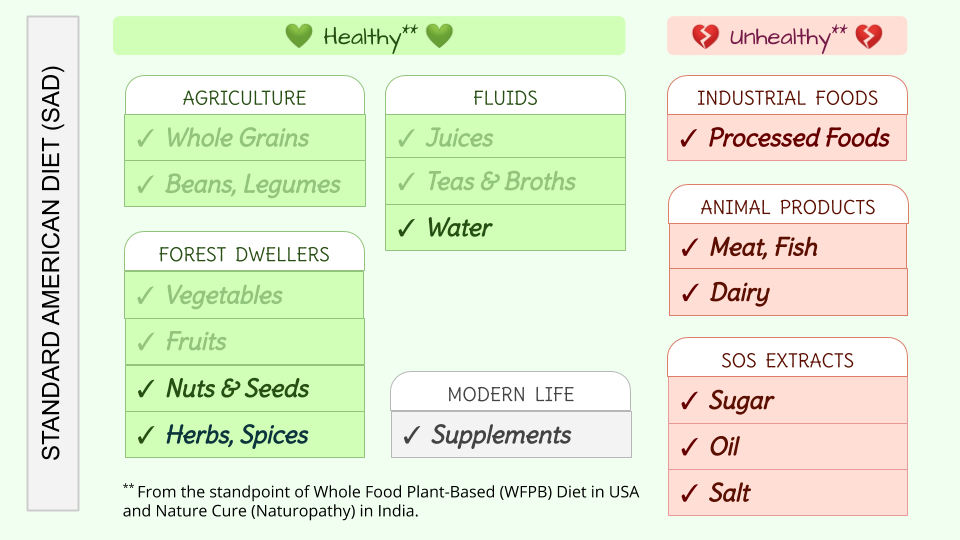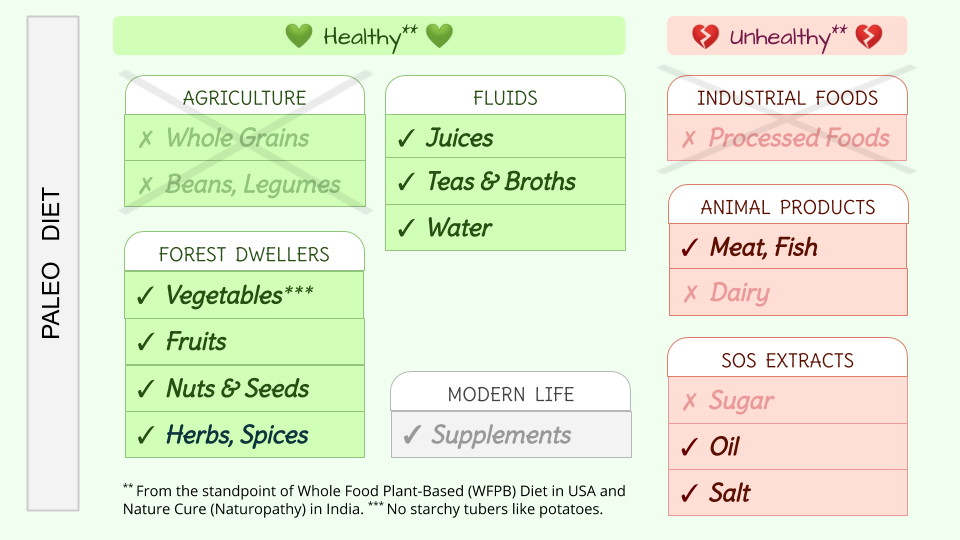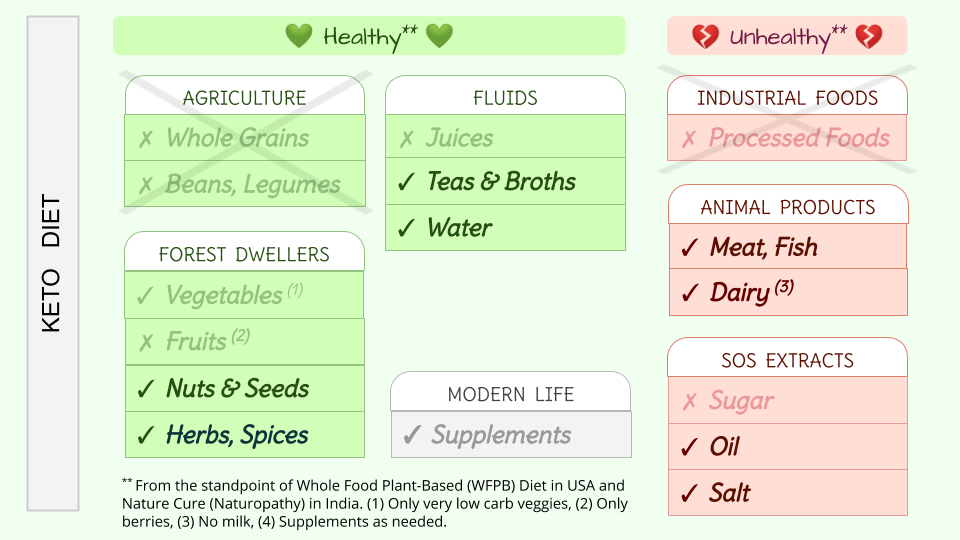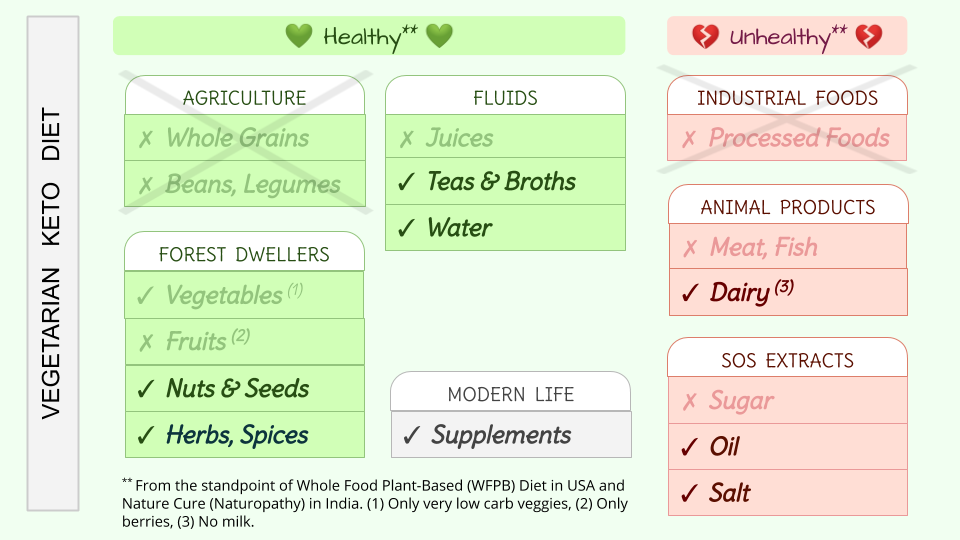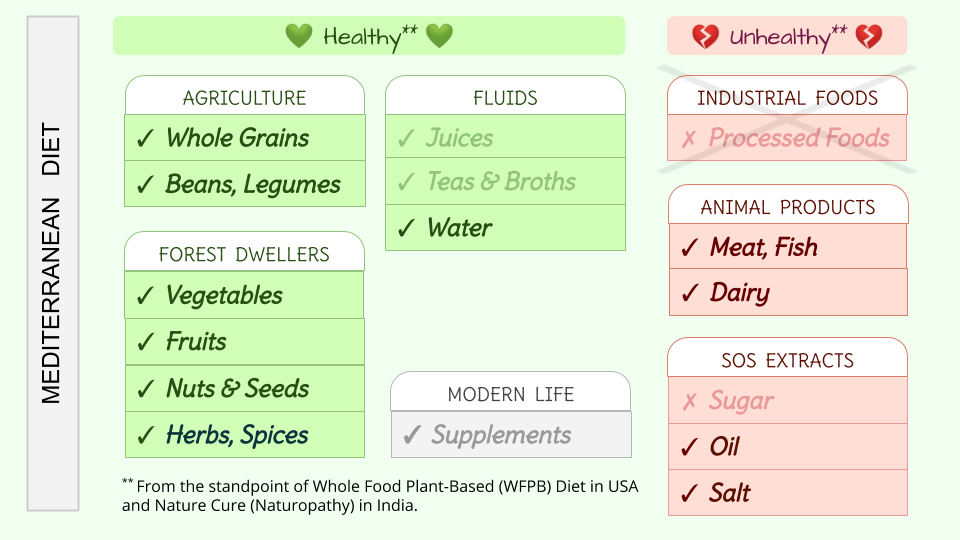In this article, we'll browse through four diets: (1) 'Eat Whatever We Feel Like' Diet, (2) Paleo Diet, (3) Keto Diet (including its vegetarian version), and (4) Mediterranean Diet.
In USA, if we follow the 'Eat Whatever We Feel Like' approach to food intake, we don't naturally gravitate towards vegetables, fruits, beans and grains. For a variety of socio-economic reasons, many of us gravitate towards highly processed animal products typified by pizzas, sugary drinks, steaks, hamburgers, ice creams, cookies, cakes, and so on. Such food choices are unfortunate. In USA, some people use a pejorative term SAD (Standard American Diet) for such a food system. Personally, I don't like this term but it's popular in healthy eating articles. Some speakers say that Standard American Diet leads to Standard American Diseases (more SAD) and Standard American Deaths (even more SAD).
I did follow the 'Eat Whatever We Feel Like' Diet for about 9 years of my life, so I have some personal experience with it. Coincidentally, this time period was also the most stressful phase of my life.
Mayo Clinic explains Paleo Diet succinctly. It entails heavy intake of Meat and Fish. The idea is to mimic how our ancestors lived in pre-agriculture eras. So Dairy (Milk and Milk products), Grains and Beans & Legumes are not consumed — all of these became part of our diet only with the advent of agriculture. In addition, Processed Foods, especially Processed Meats, are eliminated because these foods have only recently been created.
In a Paleo Diet, the emphasis is on Animal Sources: every meal — breakfast, lunch and dinner — has a main dish derived from Animal Products (Lean Meats, Fish), with a side dish derived from Plant Sources, for example, a salad. For details, Mayo Clinic article on Paleo Diet has a section titled "A Typical Day's Menu".
Part 4: Pre-Agriculture, Agriculture & Modern Food Sources traces the history of various food sources. It is important to note that modern foods — from both animal sources and plant sources — are very different from what and how our ancestors ate. Through selective breeding, we have modified the plants and animals that we consume for food. Additionally, hunter-gatherers didn't subsist predominantly on hunting. Gathering of plant-based sources was a significant part of pre-agriculture eras. Some clues into these lifestyles are gleaned from modern day hunter gatherer communities. These points are highlighted in these articles: How Hunter Gatherers Really Eat (Scientific American, 2013) and Evolution of Diet (National Geographic, 2013).
Notes on Paleo Diet:
* The main difference between Paleo Diet and WFPB Diet pertains to (Lean Meats, Fish, Oils) vs (Grains, Potatoes). Paleo Diet emphasizes the former; WFPB doctors advocate the latter. Other inclusions and exclusions are the same.
* WFPB doctors acknowledge that Paleo Diet is a step in the right direction because it weans us away from (Red Meats, Dairy Products, Salt, Sugar and Processed Foods) — see the column "What To Avoid" for Paleo Diet above. According to WFPB doctors, even though (Lean Meats, Fish, Oils) were retained and (Grains, Potatoes) were eliminated, the overall system is far better than the Standard American Diet or the 'All Foods Diet'.
* Tubers: In a Paleo Diet, potatoes receive special mention. Potatoes belong to a class of vegetables called tubers, which includes potatoes, sweet potatoes, yams, cassava, taro, and so on, all of which are rich sources of 'starches' (carbohydrates).
* Starches: Grains are also abundant sources of 'starches' (carbohydrates). Paleo Diet avoids starches, so both Grains and Tubers are eliminated. On the contrary, WFPB docors recommend a starch-rich diet centered around Grains and Tubers. Dr John McDougall explicitly calls his WFPB Diet a 'starch-based diet'. He has written a book along this theme called The Starch Solution (368 pages, 2013). YouTube has John McDougall's talk on Starch Solution (75 mins).
Were Paleolithic people actually eating plants? See Paleo Diet.
This article explains Keto Diet and its variants nicely. The goal is to consume 60% to 75% of calories as fats, 20% to 35% of calories as proteins and only 5% of calories as carbohydrates.
In a Keto Diet, the emphasis shifts to meats, fatty fish, eggs, butter and cream, cheese, nuts n seeds, oils, avocados, low carb veggies. Along with a huge reduction or elimination of grains, fruits, beans and legumes, root vegetables, and so on.
A Vegetarian Keto Diet also exists. See How to Folow a Vegetarian Keto Diet.
Notes on Keto Diets:
* Diet Doctor explains Keto Diet in great detail. Here are some guidelines for varous food sources: Fruits & Berries — Vegetables — Red Meat, and so on.
* I never adopted Paleo or Keto Diets, so have no personal experience with them. Since 2012, I have followed a Whole Food Plant-Based (WFPB) diet which is described in its own section.
* In India, Veeramachaneni Diet is a Keto Diet (Quora article that explains this diet in detail). There must be other similar diets in India — if you know of them, please let me know — I'll list them here.
* Most practitioners of keto diets consume animal products. However, it's possible to construct a 'vegan keto' diet with zero animal products!
* WFPB doctors don't recommend Keto Diets at all because such diets eliminate grains, most vegetables and fruits. Additionally, Keto Diets emphasize 'high fat' whereas WFPB emphasizes exactly the opposite: 'low fat'.
Mediterranean Diet is outlined here.
* Among the diets that include animal products, Mediterranean Diet is probably the best for disease prevention and cure — it is often advocated by contemporary nutritionists in the West. For example, see Mediterranean Diet explained by American Heart Association.
* In terms of inclusions and exclusions, Mediterranean Diet is similar to Paleo Diet. The main difference lies in the emphasis on different food categories; the calorie distribution over these food categories is different.
* Browsing through Sample Menu for 1 Week for Mediterranean Diet and A Typical Day's Menu in Paleo Diet, we notice that Mediterranean Diet emphasizes Plant Sources (Whole Grains, Vegetables, Fruits, Legumes, Nuts n Seeds, Herbs n Spices), along with Animal Sources (Lean Meats, Fish, Dairy Products) consumed in 'low to moderate amounts' (see Mediterranean Diet explained by American Heart Association).
The main dishes of many meals in Mediterranean Diet are centered around Plant Sources; starch sources like grains and potatoes (tubers) are consumed in abundance. In contrast, the main dishes of all three meals in Paleo Diet are centered around Animal Sources; starch sources like grains and potatoes (tubers) are eliminated. In a nutshell, that is the main difference between Mediterranean and Paleo.
* Among the extracts (Salt, Oil, Sugar), Oil is retained in Mediterranean Diet but limited to cold pressed oils like olive oil; Salt is reduced to nominal amounts; Sugar (refined sugars) is eliminated.
* From the standpoint of Whole Food, Plant-Based (WFPB) doctors, the transitions from All Foods Diet (or 'Supermarket Diet') → Paleo Diet → Mediterranean Diet are awesome because of elimination of Processed Foods, elimination of extracts like Sugar (refined sugars), major reduction in extracts like Oil and Salt, and the shift in emphasis from animal sources (Meats, Fish, Dairy Products) to plant sources (Vegetables, Fruits, Legumes, Whole Grains, Herbs & Spices, Nuts & Seeds). In WFPB, the pendulum swings all the way to plant sources.
* WFPB doctors don't recommend Keto Diets at all because such diets eliminate grains, most vegetables and fruits. Additionally, Keto Diets emphasize 'high fat' whereas WFPB emphasizes exactly the opposite: 'low fat'.
* Food Rules — Illustrated (224 pages, 2011) by Michael Pollan and Maira Kalman is a beautifully illustrated version of Michael Pollan's earlier book Food Rules (140 pages, 2009). All rules are listed in a 2-page article here.
Michael Pollan does not spell out a diet or a complete food system with examples of food plates. So there is no 'Michael Pollen Diet' in place. Instead, he has devised a series of food guidelines called 'Food Rules'. These rules contain points from both Mediterranean Diet and Whole Food, Plant-Based (WFPB) Diet, so they are likely to appeal to both communities. In my opinion, they lean more towards Mediterranean Diet even though the summary of his food philosophy is captured by his 7-word slogan 'Eat Foods, Mostly Plants, Not Too Much' which makes it sounds like WFPB.

 Instagram
Instagram YouTube
YouTube